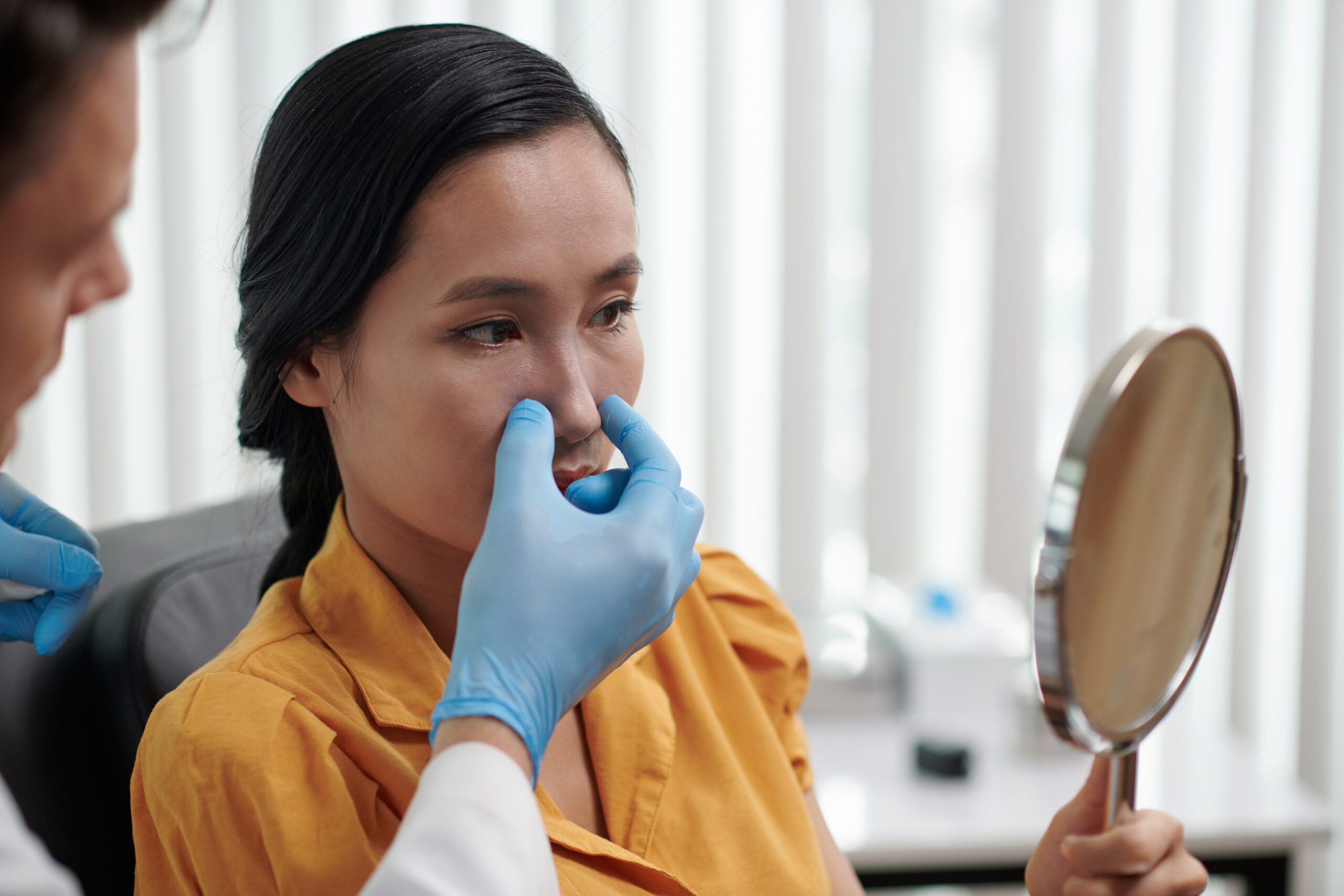Nose cosmetic surgery is one of the most refined and personalized procedures in modern nose aesthetics. Also known as rhinoplasty or a nose job, this surgery aims to balance the face, correct structural issues, and create natural results that suit each person’s unique features.
But there’s one factor that quietly shapes every result, your skin. Its thickness, texture, and elasticity all play a major role in how your new nose will look after healing. Many patients focus on bone structure and cartilage shape, but in reality, the skin covering the nose can either reveal or hide those surgical refinements.
In this blog, the best rhinoplasty surgeon in Turkey, will explore why skin type matters for nose cosmetic surgery, what surgeons look for during consultations, and how you can prepare your skin for the best outcome possible.
Contents
- 1 Understanding Nose Cosmetic Surgery
- 2 Why Skin Type and Thickness Matter in Nose Cosmetic Surgery
- 3 How Surgeons Analyze Skin Before Nose Cosmetic Surgery
- 4 Managing Expectations Based on Skin Type
- 5 Can You Improve Skin Condition Before Nose Cosmetic Surgery?
- 6 Realistic Results and the Importance of Surgeon Expertise
- 7 The Balance Between Skin and Structure
Understanding Nose Cosmetic Surgery
What Nose Cosmetic Surgery Involves
At its core, nose cosmetic surgery reshapes the nasal structure to improve nose aesthetics and breathing function. The surgeon works with bone, cartilage, and soft tissue to create a harmonious and balanced shape. Depending on the case, it can involve removing a bump, refining the nasal tip, narrowing the bridge, or correcting asymmetry.
There are two main approaches to rhinoplasty: open and closed rhinoplasty. Open rhinoplasty uses a small incision between the nostrils for full visibility of the nasal framework, often preferred for complex reshaping. Closed rhinoplasty keeps all incisions inside the nostrils, leaving no external scars and reducing swelling.
Both methods rely heavily on how your skin heals and adapts to the new structure underneath. Even the most precise surgical work can appear different depending on how thick or thin your skin is.
Common Goals of Rhinoplasty Procedures
Patients seek nose cosmetic surgery for many reasons, aesthetic, medical, or both. Common goals include:
- Smoothing a hump or bump along the nasal bridge
- Refining a bulbous or drooping nasal tip
- Straightening a crooked nose
- Narrowing wide nostrils
- Improving airflow for easier breathing
According to the American Society of Plastic Surgeons (ASPS), over 350,000 rhinoplasty procedures were performed in the United States in 2024, making it one of the top five cosmetic surgeries nationwide. While goals vary, the key to a successful outcome always lies in tailoring the procedure to the patient’s anatomy, and that includes the skin.
Why Skin Type and Thickness Matter in Nose Cosmetic Surgery

How Skin Thickness Affects Surgical Results
Your skin acts like a blanket over the nasal framework. If it’s thin, it can reveal every fine detail beneath it, which can be both a blessing and a challenge. Thin-skinned patients often see sharper, more defined results, but small irregularities or asymmetries can also become visible.
In contrast, thick skin can hide fine details, making it harder to achieve delicate tip definition. However, it can also mask minor imperfections and provide a smoother surface overall. Surgeons must adapt their technique based on this factor, often shaping the underlying cartilage differently to create balance.
A study published in Plastic and Reconstructive Surgery Journal found that skin thickness is one of the most influential factors in postoperative satisfaction. Patients with thicker skin may need longer healing times, while thin-skinned patients must be cautious about visible irregularities.
The Role of Skin Elasticity and Healing
Elasticity determines how well the skin contracts and settles over the new nose shape. Younger patients typically have more elastic skin, allowing it to adapt smoothly. Over time, elasticity decreases, which can affect how well the skin conforms to the reshaped structure.
Healing also varies with skin type. Thick, oily skin tends to swell more and takes longer to settle, while thinner skin may heal faster but can show redness and irregularities early on. Surgeons often prepare patients for these differences so expectations match reality.
Differences Between Thin and Thick Nasal Skin
| Skin Type | Advantages | Challenges |
|---|---|---|
| Thin Skin | Sharp definition, refined results | Visible irregularities, more delicate healing |
| Thick Skin | Smooth surface, hides imperfections | Less tip definition, prolonged swelling |
| Oily Skin | Healthy circulation, good hydration | More prone to swelling and slower healing |
| Dry Skin | Quick healing, easy to manage | Can flake or tighten during recovery |
Understanding where your skin falls on this spectrum helps set realistic expectations for your rhinoplasty outcome.
How Surgeons Analyze Skin Before Nose Cosmetic Surgery
Assessing Skin Quality During Consultation
During your initial consultation, your surgeon will gently feel your nasal skin and observe its thickness, oiliness, and elasticity. This helps them predict how the skin will behave during healing and how much definition can realistically be achieved.
Experienced surgeons know that cosmetic nose surgery is not one-size-fits-all. Instead, they plan every detail, from incision type to graft placement, according to your skin’s response.
What Surgeons Look for in Skin Texture, Pores, and Oil Levels

Surgeons also evaluate the texture of the skin, including visible pores, oil production, and any signs of scarring or acne. For example, oily skin with large pores tends to swell more and heal slower, while very dry skin can feel tight after surgery.
Some doctors use imaging tools or ultrasound to measure skin thickness precisely, especially in revision cases. This level of detail helps ensure the best structural approach and a smooth, natural finish.
Managing Expectations Based on Skin Type
What to Expect if You Have Thick Skin
Patients with thick nasal skin often worry their results won’t be noticeable. In reality, good results are achievable, they just require time and the right technique. Swelling may last longer, sometimes several months, and final definition can take up to a year.
Surgeons often refine the cartilage structure more aggressively in thick-skinned patients to enhance definition beneath the surface. Sometimes steroid injections are used after surgery to help control swelling.
What to Expect if You Have Thin Skin
If you have thin skin, your results may appear sooner, but healing requires care. Any unevenness or small contour change might become visible. Surgeons may use soft tissue grafts or fine cartilage shaping to prevent visible irregularities.
Patients with thin skin should avoid harsh skincare products after surgery and follow all aftercare instructions closely.
How Skin Type Can Influence Swelling and Recovery
Swelling is a normal part of recovery, but its duration and intensity vary widely. Thick, oily skin retains more fluid, so swelling can take longer to fade. Thin or dry skin usually settles faster but may show early irregularities that even out with time.
Most patients can return to light activity within two weeks, but full results may take anywhere from six months to a year.
Can You Improve Skin Condition Before Nose Cosmetic Surgery?
Pre-Surgery Skincare Tips for Better Healing
Healthy skin heals faster and looks better after surgery. Here are some pre-surgery tips that surgeons often recommend:
- Moisturize regularly to keep the skin supple and elastic.
- Avoid harsh exfoliants or peels two weeks before surgery.
- Use sunscreen daily, since sun damage can affect healing.
- Eat a balanced diet rich in vitamins A, C, and zinc for skin repair.
- Stay hydrated — proper hydration helps reduce inflammation.
These small steps can make a big difference in how your skin adapts to your new nasal structure.
What to Avoid Before Surgery (Products, Treatments, Habits)
Avoid products that cause irritation, such as retinol, acids, or acne treatments, at least a week before surgery. Smoking and alcohol can also slow healing by reducing oxygen supply and increasing inflammation.
Surgeons may also ask you to stop taking certain supplements or medications that thin the blood, such as aspirin or vitamin E. Always follow your surgeon’s pre-op instructions carefully for the safest and smoothest recovery.
Realistic Results and the Importance of Surgeon Expertise
Why Customization Matters in Nose Cosmetic Surgery
Every nose is unique, and so is every surgery. The best outcomes happen when the surgeon customizes the procedure to your anatomy, not just reshaping the cartilage but understanding how your skin will drape over it.
Customization ensures balance between skin, bone, and cartilage. A skilled surgeon will adapt their technique to your individual needs rather than using a “template” approach.
How Experienced Surgeons Adapt Techniques to Skin Type
Surgeons experienced in rhinoplasty often use specialized methods based on skin type:
- For thick skin, they may thin soft tissue layers and add tip definition with structured grafts.
- For thin skin, they may use soft-tissue padding or camouflage grafts to prevent visibility of minor irregularities.
Experience makes all the difference. On RealSelf, patients consistently report higher satisfaction with board-certified facial plastic surgeons who specialize in rhinoplasty — especially those who adjust their techniques for different skin types.
The Balance Between Skin and Structure
In nose cosmetic surgery, success isn’t only about reshaping bone or cartilage, it’s about understanding the delicate balance between structure and skin.
Your skin type, its thickness, and its elasticity determine how your results will settle, how natural they’ll appear, and how long the recovery takes. By preparing your skin, setting realistic expectations, and choosing a skilled surgeon who tailors the approach to your unique anatomy, you can achieve results that feel both beautiful and natural.
Remember, perfect results look different for everyone. The goal of modern nose aesthetics isn’t to create a “standard nose,” but to enhance your natural beauty and harmony. With expert guidance and patience, your nose job can be one of the most rewarding transformations of your life.


